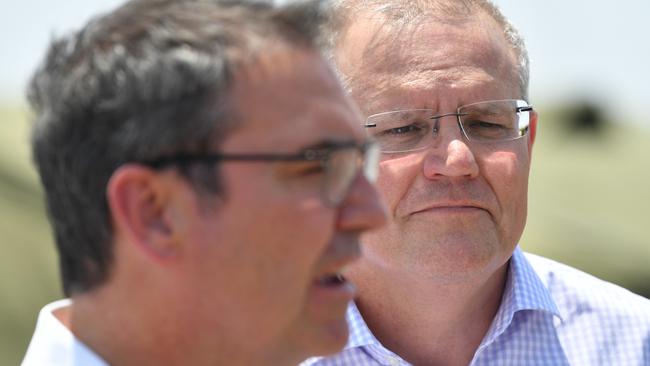SA Premier Steven Marshall pledges climate action in 2020, to tackle fires, coastal erosion and hotter suburbs
Tackling the role of climate change in bushfires, overheated suburbs and coastal erosion will be at the top of Steven Marshall’s agenda this year – with plans for SA to be a net zero carbon emitter by 2050.
SA News
Don't miss out on the headlines from SA News. Followed categories will be added to My News.
- The State: Daniel Wills - SA’s plan to tackle carbon shows political climate is finally changing
- State Government reboots defeated reforms
- Latest subscriber exclusive rewards
Tackling climate change’s role in creating catastrophic bushfires, hotter suburbs and the erosion of beaches will be a major focus of Premier Steven Marshall’s agenda for 2020.
In an interview with The Advertiser ahead of Parliament’s return next week, Mr Marshall said the reality of a warming planet also brought opportunities for SA to cash in, by developing solutions including carbon storage and supercharging the export of green energy.
Governor Hieu Van Le will on Wednesday deliver a ceremonial speech at Parliament’s reopening, which Mr Marshall has confirmed will feature bold statements on climate change.
Mr Marshall is also forecasting that 75 per cent of SA’s energy will come from renewables by 2025-26, up from about 50 per cent today, while insisting that getting bills down remains the “most important” aspect in a suite of policies that can be delivered without “smashing jobs”.
He said “things have changed” since the devastating Adelaide Hills and Kangaroo Island bushfires, as the public demanded a clear vision for practical climate adaptation and resilience.
“It has changed the psyche of the people of SA, and Australia,” Mr Marshall said.
“There were a whole pile of people that were wavering on their interest in regards to climate resilience and adaptation.
“There was probably a fear amongst some people that a new Liberal government might move away from a direction that had been set in terms of climate.
“Any reasonable independent view of what has happened shows that we have actually put our foot down.
“We will do a better job this year of explaining exactly how that is working.”

The comments and policy direction are in stark contrast to the Federal Coalition, which is battling claims of ignoring climate science and calls to increase emissions reduction targets.
Mr Marshall says SA should be a net zero carbon emitter by 2050. He conceded “no matter what we do in SA we are not going to change global weather patterns”, but stressed SA should do its part and needed a plan to deal with local climate change impacts regardless.
The State Government in December released a high-level “climate smart” strategy with ambitions to reduce emissions, unlock innovation, build resilience and provide better research.
A detailed climate change strategy implementation plan is due by the middle of the year.
Mr Marshall said key measures would include planting more trees to combat “hotter and drier” suburbs, ensuring the coastline was protected against worsening erosion, readying for a “greater level of bushfires” and seeking to export more clean power to the world.
“Our coast is right on that frontline of the climate change impact in SA,” he said.
“Another thing is cooling our suburbs. It is hotter and drier, so this whole concept of green Adelaide, where we are planting more trees and cooling our suburbs will become a focus.
“It’s how you adapt when you have got a changing climate.”
The final strategy will also feature opportunities in the protection and promotion of nature tourism, so-called “blue carbon” storage in the seagrass and mangroves and energy export.
Mr Marshall highlighted a particular opportunity in hydrogen power, as countries including Japan and Singapore earmark the emerging technology for a much larger share of their energy.
Mr Marshall said SA’s renewable energy increase could be achieved by a combination of expanding home solar and storage, more big grid-scale batteries and new green power plants.
“The previous (Labor) government put us into an invidious position where we had to have a diesel generator, which always seemed to me to be one of the most hilarious examples of public policy in history,” he said.
“Often Governments are tempted by announcing one ‘big bang’ solution. It very rarely actually works. What we’ve got is a suite of programs.
“With the changing technology, it creates enormous opportunity for us to improve our grid stability, lower prices and cut our emissions at the same time.
“Years ago when you were reducing emission there were going to be costs associated with that, to households and businesses and grid stability. That doesn’t necessarily have to be the way going forward.
“We can have win-win.”
Before the last SA election, former premier Jay Weatherill pledged to achieve 75 per cent renewable energy by 2025, as Mr Marshall promised to abolish a state-based renewable energy target on the grounds that was the Federal Government’s role in a national grid.
Analysis then indicated that private investments, particularly UK billionaire Sanjeev Gupta’s Whyalla rescue plan, would lead to the 75 per cent result without any political intervention.
Asked whether Prime Minister Scott Morrison and the Federal Government should do more, Mr Marshall said: “Energy policy in Australia is complex. You’ve got disparate views on what should happen and you’ve got to get states and territories on the same page”.
“That is actually a big task,” he said.
“It didn’t occur under federal Labor, it hasn’t occurred under the Coalition.
“We are where we are. SA is making the best of the current set of circumstances.”
